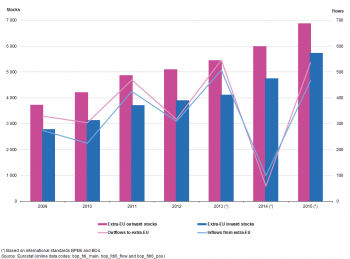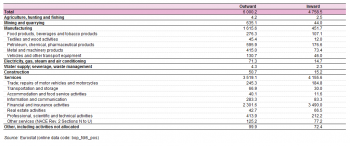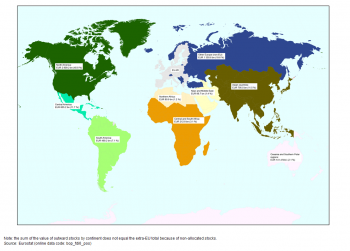Archive:Foreign direct investment statistics
- Data from April 2017. Most recent data: Further Eurostat information, Main tables and Database.

(billion EUR)
Source: Eurostat (bop_fdi_main), (bop_fdi6_flow) and (bop_fdi6_pos)

Source: Eurostat (bop_fdi_main) and (bop_fdi6_flow)

(% of extra EU-28 outward flows)
Source: Eurostat (bop_fdi6_flow)

(billion EUR)
Source: Eurostat (bop_fdi_main) and (bop_fdi6_pos)

(billion EUR)
Source: Eurostat (bop_fdi6_pos)

Source: Eurostat (bop_fdi_main), (bop_fdi6_inc) and (bop_fdi6_pos)
This article gives an overview of foreign direct investments (FDI) for the European Union (EU) in relation to year-end stocks, annual flows and income. The analysis covers the period 2009–2015 for the EU-28; note that the 2013–2015 figures are based on new methodological standards — Balance of Payments Manual, 6th edition (BPM6), and Benchmark Definition of FDI, 4th edition (BD4) — and therefore that the statistics from 2013 onwards are not directly comparable with those for previous years.
Main statistical findings
Key points
Both EU inward flows (direct investments in EU Member States from non-member countries) and outward flows (EU Member States’ direct investments in countries outside the EU) fell sharply in 2014 and were at their lowest levels during the period 2009–2015. These big falls were mainly due to large disinvestments in the traditional partner countries — the United States and Switzerland — as well as disinvestments from the United States in the EU. In 2015, the level of inward and outward FDI flows returned to a similar level to that recorded in 2013.
FDI stocks increased in 2015 and followed the trend from previous years, albeit with a higher rate of increase than recorded in recent years. The income rates of return from both EU-28 outward and inward investments decreased slightly in 2015 compared with 2014. As in earlier years, FDI flows channelled through special-purpose entities [1] played a significant role in the results.
FDI flows
FDI flows declined sharply in 2014 but rebounded in 2015
EU Member States’ direct investments in countries outside the EU (outward flows)
After having increased during the years 2009–2013 the EU Member States’ direct investments in countries outside the EU declined sharply in 2014 and were at their lowest level during the period 2009–2015 (see Figure 1) [2]. This big fall was mainly due to large disinvestments in some traditional partner countries — the United States (EUR -83.3 billion) and Switzerland (EUR -33.0 billion) — see Table 1. Disinvestments were particularly high for equity capital acquisitions in the United States market that went from EUR 206.8 billion in 2013 to EUR -85.0 billion in 2014.
EU Member States’ direct investments also fell significantly in Central America, but remained positive at a total of EUR 35.0 billion. This was mainly due to decreased EU FDI activities with offshore financial centres located in this area, where special-purpose entities play an important role.
In 2015, the EU Member States’ direct investments in countries outside the EU rebounded strongly, nearly recovering to the level recorded in 2013. In particular investments in the United States and Switzerland increased greatly, in both cases exceeding the levels of outward flows to these countries in any of the years from 2012 to 2014. Equally, investments in South Africa in 2015 were far higher than in any of the other years shown in Table 1 as was also the case for investments in Turkey, Singapore and Japan.
Direct investments in EU Member States from non-member countries (inward flows)
Direct investments in the EU also fell in 2014, thus mirroring the development for outward flows. Again this was largely due to the flows with relation to the United States changing from EUR 352.8 billion in 2013 to EUR -24.8 billion in 2014, in other words from investment to disinvestment. Direct investments in the EU also declined from all other continents (except for the rest of Europe). Brazil went from direct investments of EUR 10.0 billion in 2013 to a disinvestment of EUR 2.0 billion in 2014, while Singapore went from EUR 11.7 billion of investment to EUR -4.5 billion of disinvestments.
Like outward flows, inward flows rebounded strongly in 2015, although again not quite reaching the level of 2013. In particular, investments from the United States increased greatly, reaching EUR 252.4 billion in 2015, although this remained below the level for 2013 (EUR 352.8 billion). In 2015, investments from Switzerland, Canada, the Arabian Gulf countries and Singapore were higher than in any of the other years shown in Table 1. Investments in the EU from offshore financial centres also rebounded strongly in 2015, reaching EUR 83.0 billion, just below the level observed in 2012 (EUR 84.9 billion).
Luxembourg remained the leading EU investor in countries outside the EU
FDI flows can vary considerably from one year to another, influenced mainly by large mergers and acquisitions. Luxembourg remained the EU Member State with the largest share of the total FDI outward flows from the EU (see Figure 2).
In the period 2013–2015, Luxembourg had a share of 40 % of total EU FDI outward flows; special-purpose entities handle most of Luxembourg’s total direct investment. Special-purpose entities also play an important role in other EU Member States, including the Netherlands, Belgium and Hungary.
North America, in particular the United States, was the top recipient, attracting around 73 % of Luxembourg’s outward FDI investments in non-member countries in 2013—2015. Offshore financial centres were also a common destination of Luxembourg’s outward FDI, reflecting the importance of the financial sector for this EU Member State.
The Netherlands’ outward FDI flows to non-member countries were also very high during 2013–2015 (33 % of the EU-28 total), pushing it into second place among the EU Member States, ahead of Spain (9 % of the total).
FDI stocks
Faster growth in 2015
Both inward and outward FDI stocks grew in 2015 at a faster pace than in 2014. Between the end of 2014 and the end of 2015, EU-28 outward stocks grew 14.9 % and inward stocks grew 20.7 %, compared with 10.0 % and 15.2 % between the end of 2013 and the end of 2014.
North America remained the main location of EU-28 FDI outward stocks in non-member countries
At the end of 2015, North America had the biggest share (40.8 %) of EU-28 FDI stocks abroad (see Map 1). The United States alone accounted for some 37.1 % (EUR 2 560 billion) of all EU-28 outward stocks (see Table 2).
European countries outside the EU accounted for 19.6 % of EU-28 outward stocks at the end of 2015. Switzerland was the second most important location, accounting for 11.9 % of EU-28 outward stocks, its main activity being financial intermediation.
At the end of 2015, Bermuda was the third main location with a 5.3 % share of EU-28 FDI outward stocks, reflecting its role as an offshore financial centre. Brazil and Canada were in fourth and fifth places, with shares of 4.8 % and 3.6 % of EU-28 FDI outward stocks. Asian countries (other than those from the Near and Middle East) accounted for 11.5 % of EU-28 outward stocks, the main locations being China, Singapore and Hong Kong. Together these three countries accounted for more than half of the EU-28’s FDI positions in Asia at the end of 2015.
The United States was the main holder of inward FDI stocks in the EU-28
At the end of 2015, the United States held more than two fifths (41 %) of total EU-28 FDI inward stocks from the rest of the world (see Table 2). The United States thus maintained its position as the major holder of FDI stocks in the EU-28, having invested, as of the end of 2014, mostly in the financial services sector, followed by manufacturing; one third of the latter was in the manufacture of petroleum, chemical, pharmaceutical, rubber and plastic products, and nearly one third in the manufacture of food products, beverages and tobacco products.
Similar to the ranking for FDI outward positions, Switzerland was the second largest FDI stock holder in the EU-28 at the end of 2015, with stocks valued at EUR 619 billion, more than half (56 %) of which were in the financial services sector (end of 2014).
Also in line with the ranking for FDI outward positions was the third place of Bermuda, with 8.6 % of EU-28 FDI inward stocks at the end of 2015. In the ranking of countries by FDI inward stocks these three partners were then followed by several countries that were not in the top 10 ranking in terms of outward stocks as well as Canada: Jersey held 3.9 % of EU-28 FDI inward stocks, Canada 3.8 %, the Cayman Islands 3.3 %, Japan 2.9 % and Gibraltar 2.8 %; several of these countries are offshore financial centres.
Continued dominance of financial services
At the end of 2014, the EU-28 had a positive FDI balance — in other words, outward stocks of FDI exceeded inward stocks (see Table 3). The activity structure of EU-28 FDI stocks remained relatively unchanged in 2014. The services sector still had a negative balance mainly due to financial services activities as almost all other services sectors registered a positive balance as did all non-service sectors.
Services made by far the largest contribution to both outward (59 %) and inward (87 %) FDI stocks for the EU-28 at the end of 2014, with the outward share slightly increased compared with the end of 2013. Around four fifths of inward stocks of services and two thirds of outward stocks of services were held in financial and insurance activities, which themselves grew during 2014.
Manufacturing was the second largest sector, with 27 % of outward stocks and 9 % of inward stocks. In particular, petroleum, chemical and pharmaceutical products constituted close to two fifths of total manufacturing FDI stocks for both inward and outward investment.
Income from FDI
EU-28 net income decreased in 2014 and 2015
The EU-28’s investment income received from non-member countries (on outward FDI) decreased in 2015 to EUR 303 billion, while EU-28 investment income paid to non-member countries (on inward FDI) increased to EUR 219 billion (see Figure 3). As a consequence, the net income on FDI decreased, falling from EUR 116 billion in 2014 to EUR 84 billion in 2015; this was the fourth successive annual decrease in net income (note that there was a change in methodology between 2012 and 2013).
The rate of return on both inward and outward FDI stocks was lower in 2015 than in 2014, down from 6.0 % to 5.0 % for outward stocks and from 5.1 % to 4.6 % for inward stocks [3].
Data sources and availability
FDI statistics in the EU are collected in accordance with Regulation (EC) No 184/2005 of the European Parliament and of the Council on Community statistics concerning balance of payments, international trade in services and foreign direct investment, and the amending Commission Regulation (EU) No 555/2012.
The methodological framework used is that of the OECD benchmark definition of foreign direct investment, either the third edition (up to the 2012 reference year) or fourth edition (from the 2013 reference year). This provides a detailed operational definition that is fully consistent with the IMF’s balance of payments manual.
This article is based on FDI data that were available in Eurostat’s database in April 2017. The series in the database covered the period from 1992 to 2015, analysed by partner, activity and type of direct investment (equity capital, loans and reinvested earnings). The FDI figures that are presented in this article for 2013–2015 are based on the new international standards — Balance of Payments Manual, 6th edition (BPM6) and Benchmark Definition of FDI, 4th edition (BD4).
EU aggregates include special-purpose entities, which are a particular class of enterprises (often holding companies).
Context
In a world of increasing globalisation, where political, economic and technological barriers are rapidly disappearing, the ability of a country to participate in global activity is an important indicator of its performance and competitiveness. In order to remain competitive, modern-day business relationships extend well beyond the traditional international exchange of goods and services, as witnessed by the increasing reliance of businesses on mergers, partnerships, joint ventures, licensing agreements, and other forms of business cooperation.
FDI may be seen as an alternative economic strategy, adopted by those enterprises that invest to establish a new plant/office, or alternatively, purchase existing assets of a foreign enterprise. These enterprises seek to complement or substitute international trade, by producing (and often selling) goods and services in countries other than where the enterprise was first established.
There are two kinds of FDI: the creation of productive assets by foreigners (so-called greenfield investments), or the purchase of existing assets by foreigners (for example, through acquisitions, mergers, takeovers). FDI differs from portfolio investments because it is made with the purpose of having control, or an effective voice, in the management of the enterprise concerned and a lasting interest in the enterprise. Direct investment not only includes the initial acquisition of equity capital, but also subsequent capital transactions between the foreign investor and domestic and affiliated enterprises.
See also
- Africa-EU - key statistical indicators
- Balance of payment statistics
- Foreign affiliates statistics - FATS
- Implementing the new international standards for foreign direct investment (FDI) statistics
Further Eurostat information
Main tables
- European Union direct investments (t_bop_fdi)
Database
- European Union direct investments (bop_fdi)
- European Union direct investments (BPM6) (bop_fdi6)
Dedicated section
Methodology / Metadata
- Balance of payments — international transactions (BPM6) (ESMS metadata file — bop_6_esms)
- European Union direct investments (ESMS metadata file — bop_fdi_esms)
- Implementing the new international standards for annual foreign direct investment (FDI) statistics
Source data for tables, figures and maps (MS Excel)
Other information
External links
- OECD Benchmark Definition of Foreign Direct Investment
- United Nations Conference on Trade and Development (UNCTAD) — FDI Statistics
Notes
- ↑ Special-purpose entities are mainly financial holding companies, foreign-owned, and principally engaged in cross-border financial transactions, with little or no activity in the Member State of residence.
- ↑ The figures for 2013–2015 have been compiled according to the new international standards (BPM6 and BD4) and therefore they cannot be directly compared with figures for previous years.
- ↑ The FDI rate of return is measured here as (FDI income of year t) / (stock of FDI at the end of year t-1).
